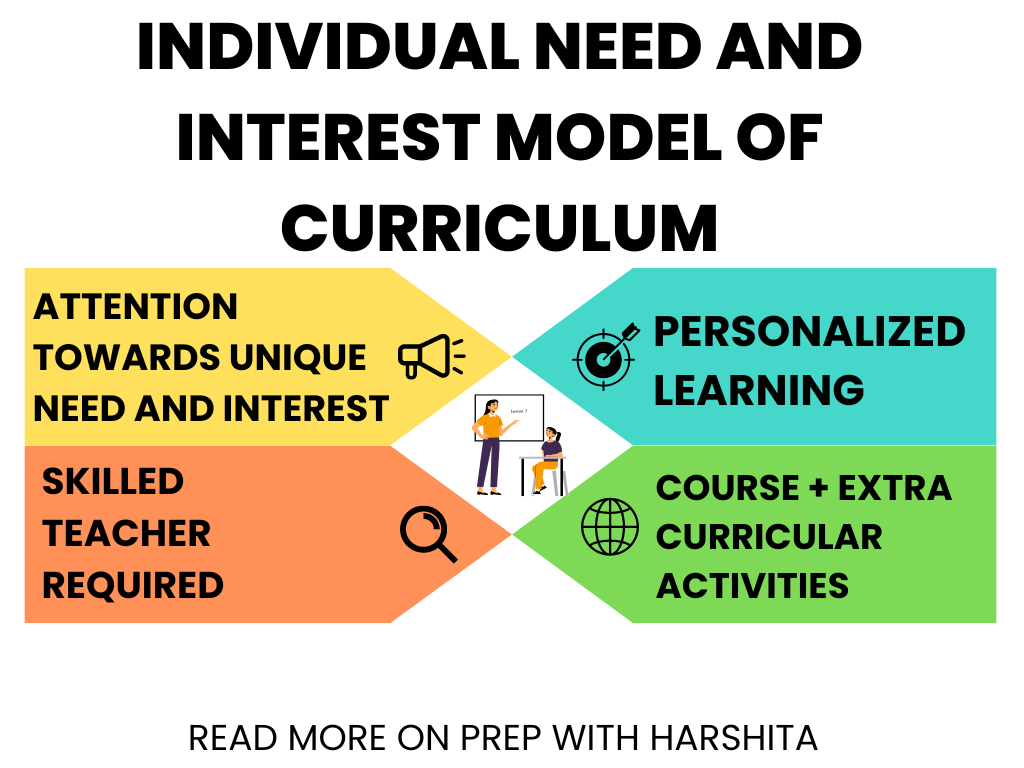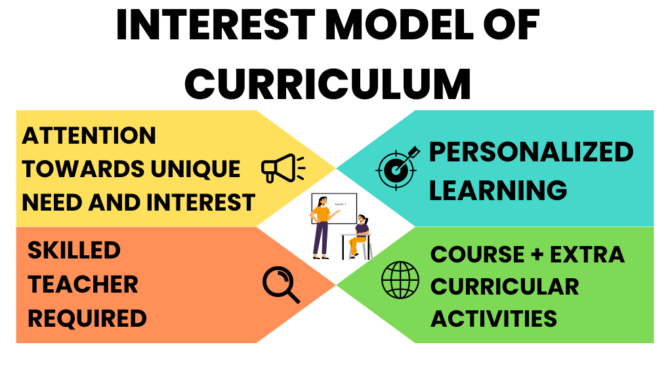The Individual Need and Interest Model of Curriculum is an approach to curriculum design that takes into account the unique needs and interests of each student.
About Individual Need and Interest Model :
- This model recognizes that students come to school with different abilities, experiences, and interests, and seeks to design a curriculum that meets those individual needs.
- The Individual Need and Interest Model is based on the belief that learning is most effective when it is personalized and relevant to the learner.
- This model emphasizes the importance of understanding each student’s learning style, interests, and abilities, and using that information to create a curriculum that is engaging, challenging, and meaningful to them.
- The curriculum designed using this model may include a combination of core academic subjects, as well as elective courses and extracurricular activities that reflect the individual interests of each student. The goal is to create a well-rounded curriculum that helps students develop their strengths, interests, and passions.
- In order to implement this model, teachers need to be skilled in assessing the individual needs and interests of their students. This may involve using a variety of assessment tools, including formal tests, informal observations, and student self-assessments. Teachers also need to be flexible and willing to adapt their teaching strategies to meet the needs of individual students.
Steps involved in implementing the Individual Need and Interest Model of Curriculum:
- Assessment of students: This step involves assessing the individual needs and interests of each student using various tools and techniques, such as informal observations, student self-assessments, and formal tests.
- Identification of learning objectives: Based on the assessment, teachers identify the learning objectives for each student. These objectives are tailored to the individual needs and interests of the student and may include academic, social, and emotional goals.
- Curriculum design: Once the learning objectives are identified, the curriculum is designed to meet the specific needs and interests of each student. This may involve selecting relevant materials, designing activities and projects, and creating assessments that align with the learning objectives.
- Implementation of the curriculum: The curriculum is implemented by the teacher in a way that takes into account the individual needs and interests of each student. This may involve using a variety of teaching strategies, such as direct instruction, small-group instruction, and individualized instruction.
- Assessment of learning: Students are assessed regularly to determine their progress toward the learning objectives. This may involve using various assessment tools, such as formative assessments, self-assessments, and summative assessments.
- Evaluation and feedback: Based on the assessment results, teachers provide feedback to students on their progress and adjust the curriculum as necessary to ensure that students are meeting their individual learning objectives.
Main features of the Individual Need and Interest model of Curriculum are:
- Personalization: The curriculum is designed to meet the specific needs and interests of each student, taking into account their learning style, prior knowledge, and individual strengths.
- Flexibility: The curriculum is flexible and adaptable, allowing teachers to adjust it as needed to meet the changing needs of individual students.
- Relevance: The curriculum is designed to be relevant and meaningful to students, with an emphasis on real-world applications and connections to their interests and experiences.
- Student-centered learning: The focus is on the learner, with students actively engaged in their own learning and taking responsibility for their progress.
- Holistic approach: The curriculum takes a holistic approach to learning, recognizing that students have emotional, social, and academic needs that are interconnected.
- Collaboration: The model encourages collaboration and communication between teachers, students, and families. It ensure that the curriculum meets the needs of each student.
- Continuous assessment: The curriculum includes ongoing assessment and feedback to ensure that students are making progress toward their individual learning objectives. Also, that the curriculum is meeting their needs and interests.
Also Read : Intervention Model of Curriculum

Also Visit : Prep with Harshita

